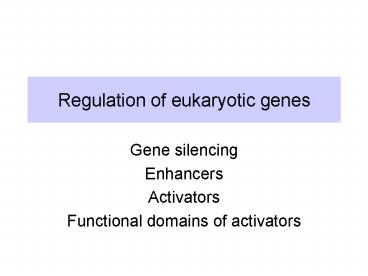Regulation of eukaryotic genes - PowerPoint PPT Presentation
1 / 18
Title:
Regulation of eukaryotic genes
Description:
Open chromatin, activated transcription: requires enhancer or upstream activator sequences ... Similar to enhancer but has an opposite effect on gene expression ... – PowerPoint PPT presentation
Number of Views:79
Avg rating:3.0/5.0
Title: Regulation of eukaryotic genes
1
Regulation of eukaryotic genes
- Gene silencing
- Enhancers
- Activators
- Functional domains of activators
2
States of eukaryotic genes
- Inactive
- Closed chromatin
- Open chromatin, but repressors or lack of
activators prevent initiation - Open chromatin, transcription has initiated, but
polymerases will not elongate. - Active
- Open chromatin, basal transcription requires
TATA Inr - Open chromatin, activated transcription requires
enhancer or upstream activator sequences
3
Silencing Mechanism
4
Silencer
- Cis-acting sequences that cause a decrease in
gene expression - Similar to enhancer but has an opposite effect on
gene expression - Gene repression - inactive chromatin structure
(heterochromatin) - Examples
- Telomeric silencing
- a or ? genes - silent loci of mating type
switching in yeast
5
Silencer binding proteins
- Silencer binding protein serve as anchors for
expansion of repressed chromatin - Rap1 protein binds to silencer elements
- SIR proteins (Silent Information Regulators)
- Nucleates assembly of multi-protein complex
hypoacetylated N-terminal tails of histones H3
and H4 - Experiments Condensed chromatin
- Resistant to DNaseI digestion
- Delete silencer - genes are derepressed
6
Gene Silencing
7
Silencing Mechanism
8
Enhancers
- Cis-acting sequences that cause an increase in
expression of a gene - Act independently of position and orientation
with respect to the gene. - Can act to
- Increase the rate of initiation at a promoter
- Increase the fraction of cells in which a
promoter is active
9
SV40 Control region
- Origin of replication
- Promoter and upstream activator sequences for
early transcription - Promoter for late transcription
- Enhancer
10
Stimulation of transcription by enhancer is
independent of orientation and position
SV40
Early
Late
T-Ag
pos
T-Ag
wt
Enhancer
orien
T-Ag
Enh-
T-Ag -
11
Enhancer contains multiple binding sites for
transcriptional activators
SV40
Early
Late
Enhancer
T-Ag
high level
A
C
B
wt
low level
C
B
deletion
high level
revertant
C
B
C
An enhanson
12
Enhancers can occur in a variety of positions
with respect to genes
Transcription unit
P
Enhancer
Enhancer
Upstream
Adjacent
Downstream
Internal
Distal
13
Activator proteins
14
Modular nature of activator proteins
- DNA binding domain recognition and binding to
specific DNA sequences - Multimerization domain allows formation of homo-
or hetero-multimers - Activation domain
- Needed for increase in expression of responding
gene - Targets are still under investigation
- General transcription factors
- Histone modifying enzymes
- Nucleosome remodeling complexes, etc
15
Modular structure of GAL4
148
1
98
196
768
881
N
C
Activation
Activation
DNA binding
GAL80 binding
Dimerization
16
Induction by galactose exposes an activation
surface
- In the presence of galactose, GAL4 activates
several genes whose products are required for
galactose metabolism. - GAL4 binds to a DNA sequence called UASG.
- In the absence of galactose, GAL80 blocks GAL4
activation. - Binding of the sugar causes GAL80 to move.
- This exposes the activation domain of GAL4.
17
Domain swap experiments show the domains are
interchangeable
- Fuse an DNA-binding domain (DBD) from one
transcription factor to the activation domain
(AD) of a different one. - DBD from LexA (E. coli)
- AD from GAL4 (yeast)
- Now a target gene can be placed under control of
the DNA binding site for the first factor - GAL1 gene with oLex (LexA binding sites) can be
activated by the fusion protein. - Basis for 2-hybrid screen for any interacting
proteins
18
Two Hybrid Screens (Interac-tion Cloning)































